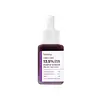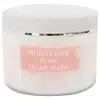What's inside
What's inside
 Key Ingredients
Key Ingredients

 Benefits
Benefits

 Concerns
Concerns

 Ingredients Side-by-side
Ingredients Side-by-side

Water
Skin ConditioningGlycolic Acid
BufferingCentella Asiatica Extract
CleansingGluconolactone
Skin ConditioningGlycerin
HumectantSodium Hydroxide
BufferingButylene Glycol
HumectantPanthenol
Skin ConditioningSalicylic Acid
MaskingPotassium Azeloyl Diglycinate
Skin ConditioningTasmannia Lanceolata Fruit/Leaf Extract
AntioxidantBiosaccharide Gum-1
HumectantDaucus Carota Sativa Extract
PerfumingVaccinium Myrtillus Bud Extract
AntioxidantAllantoin
Skin ConditioningDipotassium Glycyrrhizate
HumectantXanthan Gum
EmulsifyingAmylopectin
Dextrin
AbsorbentBenzotriazolyl Dodecyl P-Cresol
UV AbsorberChlorphenesin
AntimicrobialTetrasodium EDTA
Maltodextrin
AbsorbentPhenoxyethanol
PreservativeCitric Acid
Buffering1,2-Hexanediol
Skin ConditioningPotassium Sorbate
PreservativeEthylhexylglycerin
Skin ConditioningCI 42090
Cosmetic ColorantWater, Glycolic Acid, Centella Asiatica Extract, Gluconolactone, Glycerin, Sodium Hydroxide, Butylene Glycol, Panthenol, Salicylic Acid, Potassium Azeloyl Diglycinate, Tasmannia Lanceolata Fruit/Leaf Extract, Biosaccharide Gum-1, Daucus Carota Sativa Extract, Vaccinium Myrtillus Bud Extract, Allantoin, Dipotassium Glycyrrhizate, Xanthan Gum, Amylopectin, Dextrin, Benzotriazolyl Dodecyl P-Cresol, Chlorphenesin, Tetrasodium EDTA, Maltodextrin, Phenoxyethanol, Citric Acid, 1,2-Hexanediol, Potassium Sorbate, Ethylhexylglycerin, CI 42090
Water
Skin ConditioningCarbomer
Emulsion StabilisingPropanediol
SolventAcrylates/C10-30 Alkyl Acrylate Crosspolymer
Emulsion StabilisingHydrolyzed Adansonia Digitata Extract
EmollientHoney Extract
HumectantHyaluronic Acid
HumectantTriethanolamine
BufferingChlorphenesin
AntimicrobialPPG-1-PEG-9 Lauryl Glycol Ether
EmulsifyingPEG-40 Hydrogenated Castor Oil
EmulsifyingCoceth-7
EmulsifyingRosa Gallica Flower Powder
Skin ConditioningParfum
MaskingAscorbic Acid
AntioxidantAloe Barbadensis Leaf Extract
EmollientRuscus Aculeatus Root Extract
AstringentHydrolyzed Yeast Protein
Skin ConditioningChondrus Crispus Extract
Skin ConditioningButylene Glycol
HumectantAmmonium Glycyrrhizate
MaskingPanthenol
Skin ConditioningEscin
TonicCentella Asiatica Extract
CleansingCalendula Officinalis Flower Extract
MaskingSodium Hyaluronate
HumectantWater, Carbomer, Propanediol, Acrylates/C10-30 Alkyl Acrylate Crosspolymer, Hydrolyzed Adansonia Digitata Extract, Honey Extract, Hyaluronic Acid, Triethanolamine, Chlorphenesin, PPG-1-PEG-9 Lauryl Glycol Ether, PEG-40 Hydrogenated Castor Oil, Coceth-7, Rosa Gallica Flower Powder, Parfum, Ascorbic Acid, Aloe Barbadensis Leaf Extract, Ruscus Aculeatus Root Extract, Hydrolyzed Yeast Protein, Chondrus Crispus Extract, Butylene Glycol, Ammonium Glycyrrhizate, Panthenol, Escin, Centella Asiatica Extract, Calendula Officinalis Flower Extract, Sodium Hyaluronate
Ingredients Explained
These ingredients are found in both products.
Ingredients higher up in an ingredient list are typically present in a larger amount.
Butylene Glycol (or BG) is used within cosmetic products for a few different reasons:
Overall, Butylene Glycol is a safe and well-rounded ingredient that works well with other ingredients.
Though this ingredient works well with most skin types, some people with sensitive skin may experience a reaction such as allergic rashes, closed comedones, or itchiness.
Learn more about Butylene GlycolCentella Asiatica Extract (Centella) is derived from an herb native to Southeast Asia. It is famous for its anti-inflammatory and soothing properties.
Centella is rich in antioxidants and amino acids, such as Madecassic Acid and Asiaticoside.
Studies show the compounds in centella help with:
The combination of all these properties makes centella effective at soothing, hydrating, and protecting the skin.
Other great components of centella include Vitamin A, vitamin C, several B vitamins, and Asiatic Acid.
Fun fact: Centella has been used as a medicine and in food for many centuries. As a medicine, it is used to treat burns, scratches, and wounds.
Learn more about Centella Asiatica ExtractChlorphenesin is a synthetic preservative. It helps protect a product against bacteria in order to extend shelf life. In most cases, Chlorphenesin is paired with other preservatives such as phenoxyethanol and caprylyl glycol.
Chlorphenesin is a biocide. This means it is able to help fight the microorganisms on our skin. It is also able to fight odor-releasing bacteria.
Chlorphenesin is soluble in both water and glycerin.
Studies show Chlorphenesin is easily absorbed by our skin. You should speak with a skincare professional if you have concerns about using Chlorphenesin.
Learn more about ChlorphenesinPanthenol is a common ingredient that helps hydrate and soothe the skin. It is found naturally in our skin and hair.
There are two forms of panthenol: D and L.
D-panthenol is also known as dexpanthenol. Most cosmetics use dexpanthenol or a mixture of D and L-panthenol.
Panthenol is famous due to its ability to go deeper into the skin's layers. Using this ingredient has numerous pros (and no cons):
Like hyaluronic acid, panthenol is a humectant. Humectants are able to bind and hold large amounts of water to keep skin hydrated.
This ingredient works well for wound healing. It works by increasing tissue in the wound and helps close open wounds.
Once oxidized, panthenol converts to pantothenic acid. Panthothenic acid is found in all living cells.
This ingredient is also referred to as pro-vitamin B5.
Learn more about PanthenolWater. It's the most common cosmetic ingredient of all. You'll usually see it at the top of ingredient lists, meaning that it makes up the largest part of the product.
So why is it so popular? Water most often acts as a solvent - this means that it helps dissolve other ingredients into the formulation.
You'll also recognize water as that liquid we all need to stay alive. If you see this, drink a glass of water. Stay hydrated!
Learn more about Water